It looks like you're using an Ad Blocker.
Please white-list or disable AboveTopSecret.com in your ad-blocking tool.
Thank you.
Some features of ATS will be disabled while you continue to use an ad-blocker.
share:
Originally posted by mcx1942
I just do not see why it is not possible the lathe was actually used in Egypt at 2,800. Petrie thought so as well. It makes sense and it would explain these, because quite frankly some of these are too perfect to be done by hand. I understand the generations of craftsmanship being passed down but come on, why is it not possible that the lathe was actually being used at 2,800.
Because that disrupts the paradigm.
It disrupts nothing at all.
Archaeology has no choice but to present the evidence they have, not the evidence that "might" exist but they don't have.
Because these things can be made without a lathe or a wheel, and because no evidence for the lathe or the wheel exists for the earlier time periods (as you pointed out,) they cannot postulate the use of either.
But, nobody has stopped digging you know. If they find a lathe, they'll certainly publish it.
Harte
I do not discredit the Egyptians and if these were done by hand the good on them. I just understand that we can not truly prove how they were crafted, yet. We still have so much to discover, only the smallest fraction of what the truth actually is has be uncovered.
I think we can agree on that.
edit on 1/6/2013 by mcx1942 because: fix
Originally posted by mcx1942
I am not saying that the AEs did not posses the technology. I am asking why mainstream archaeology says they did not. The workmanship needed would require materials we are told they did not use or have.
This was my first response post way back on page one. This was never answered. Pointless arguments, some good debates and all around interesting thread. Yet this simple question was never truly answered.
It was but you didn't like the answer you recieved. I noted that Harte has answered the question again above
You stated earlier
I have proven that the Ancient Egyptians did not use the tools needed to make the vases I presented, at the time they are from. History tells us that. So we must have the timeline wrong and the Ancient Egyptians had the Lathe, Wheel and or Pottery Wheel before mainstream history has told us they 'acquired' them.
Actually you didn't prove anything you just put forward a hypothesis
Your post
Originally posted by Harte
Because these things can be made without a lathe or a wheel, and because no evidence for the lathe or the wheel exists for the earlier time periods (as you pointed out,) they cannot postulate the use of either.
Please show me the work done by modern man showing how the Petrie 2,800BC vases were made, without the lathe or wheel. That leaves only the pottery wheel and out of all the information that has been provided I have not seen how the 2,800 vases were thought to be made.
I see how the newer vases are thought to be made with the tools needed(which is backed up by evidence left by the Egyptians). I find it hard to believe this vase below was made by hand with tools made from copper. Maybe I missed the link explaining how these vases(Petrie's 2,800BC) were made. I am not trying to be a jerk, I would just like a better explanation to these vases discussed in the thread. Not all vases ever made, just these Petrie 2,800BC vases.
Beautiful Granite Vase dated to be from 2,800 BC or earlier.

This one piece is so flawlessly turned that the entire bowl (about 9" in diameter, fully hollowed out including an undercut of the 3in opening in the top) balances perfectly (the top rests horizontally when the bowl is placed on a glass shelf) on a round tipped bottom no bigger than the size and shape of the tip of a hen's egg.

This requires that the entire bowl have a symmetrical wall thickness without any substantial error! (With a base area so tiny - less than .15 " sq - any asymmetry in a material as dense as granite would produce a lean in the balance of the finished piece.)
I have never once stated your ideas and theories are incorrect. I have always stated they are theories. I just have not seen sufficient evidence to explain the 2,800BC vases. The newer vases, yes, plenty of evidence because it fits the time frame of Egyptian Archaeology.
Really interesting thread.
There is a lot buried in artifacts and architecture from the past for those with the ability to read them, like the elites always could, so this information was always passed on, not just found in artifacts such as vases.
The Holy Grail Vortex - Avebury . Part 1 of 9
Basically alot of science and astronomy passed along, physics passed along.
There is a lot buried in artifacts and architecture from the past for those with the ability to read them, like the elites always could, so this information was always passed on, not just found in artifacts such as vases.
The Holy Grail Vortex - Avebury . Part 1 of 9
Basically alot of science and astronomy passed along, physics passed along.
Originally posted by mcx1942
Originally posted by Harte
Because these things can be made without a lathe or a wheel, and because no evidence for the lathe or the wheel exists for the earlier time periods (as you pointed out,) they cannot postulate the use of either.
Please show me the work done by modern man showing how the Petrie 2,800BC vases were made, without the lathe or wheel.
Modern Man did not make these, if you mean Man in the current time era, so why would I need to show you this?
Today, we do have lathes and power drills so why would anyone make vases that way today? To arrange to go bankrupt?
Originally posted by mcx1942
That leaves only the pottery wheel and out of all the information that has been provided I have not seen how the 2,800 vases were thought to be made.
Then you haven't been reading the thread.
Originally posted by mcx1942
I see how the newer vases are thought to be made with the tools needed(which is backed up by evidence left by the Egyptians). I find it hard to believe this vase below was made by hand with tools made from copper. Maybe I missed the link explaining how these vases(Petrie's 2,800BC) were made. I am not trying to be a jerk, I would just like a better explanation to these vases discussed in the thread. Not all vases ever made, just these Petrie 2,800BC vases.
Most of the real work is done with pounding and rubbing stones, not with copper. Copper tube drills (hole saws) were used to hollow these things, but the surfaces are pounded down and polished down with other stones.
Originally posted by mcx1942
Beautiful Granite Vase dated to be from 2,800 BC or earlier.
This one piece is so flawlessly turned that the entire bowl (about 9" in diameter, fully hollowed out including an undercut of the 3in opening in the top) balances perfectly (the top rests horizontally when the bowl is placed on a glass shelf) on a round tipped bottom no bigger than the size and shape of the tip of a hen's egg.
This requires that the entire bowl have a symmetrical wall thickness without any substantial error! (With a base area so tiny - less than .15 " sq - any asymmetry in a material as dense as granite would produce a lean in the balance of the finished piece.)
That could be true, but it could also be true that the interior in the bottom has a thicker wall, making the vase bottom-heavy, which would result in it naturally sitting that way, and looking as if it were "perfectly balanced."
Originally posted by mcx1942
I have never once stated your ideas and theories are incorrect. I have always stated they are theories. I just have not seen sufficient evidence to explain the 2,800BC vases. The newer vases, yes, plenty of evidence because it fits the time frame of Egyptian Archaeology.
Obviously, theories are all we have until we come up with time travel, right?
My point (and Hans and others) is that we don't need to assume some mysterious technology nor some outside force/influence because the fact is, these things can be made using the technology available at the time.
Note that I didn't say "easily" made.
At any rate, no matter how they were made, Archaeology itself is restrained by the dictate that they must only base their findings on the actual evidence they have in hand, and not on a supposition of how a thing "must have been" made. So, until evidence is found to the contrary, made with copper and stone tools will be the mainstream position. It's perfectly justifiably so. How could it be anything else?
Hence, it's not rational to belittle (not you, necessarily, but you know what I mean) Archaeology for doing their job in the only possible way they can.
Harte
reply to post by Harte
Thank you. That was very well said. Best so far in the entire thread.
Thank you for your contributions to this thread, I do appreciate it.
Now, we just need to get our hands on a stinking time machine so we can finally put our theories to rest!
Thank you. That was very well said. Best so far in the entire thread.
Thank you for your contributions to this thread, I do appreciate it.
Obviously, theories are all we have until we come up with time travel, right?
Now, we just need to get our hands on a stinking time machine so we can finally put our theories to rest!
Originally posted by mcx1942
reply to post by Harte
Thank you. That was very well said. Best so far in the entire thread.
Thank you for your contributions to this thread, I do appreciate it.
Then you are certainly one of the few!
Most people here can't stand others to show why they are wrong, which is what I'm usually doing.
Harte
reply to post by Harte
Isn't what you wrote here an example of the false debating device known as a 'strawman'..? Take the most apparently weak aspect of a particular argument, associate it with something ridiculous/ make it sound utterly baseless by associating it with a premise that has nothing to do with the original argument, and then insinuate that you have somehow trashed that original argument..? This despite the fact that you've done nothing of the sort, and have in fact demonstrated convincingly that you are toeing a particular 'party line' (one that is full of formally agreed notions / 'conclusions' ) and that you are keenly aware of which positions need defending at all costs - even at the expense of intellectual integrity?
The point is, I've made a flint arrowhead myself, when I was ten years old.
However, I've never seen anyone - not even professional masons/ construction engineers - come even close to replicating certain features of ancient megalithic architecture. Neither have I read a convincing argument in favour of the 'official academic' conclusions regarding the same. The official lines of reason all seem willfully blind / blinkered / industrially impractical / presumptive / downright ridiculous / intellectually dishonest - or a combination of these.
How can you compare the making of a flint arrowhead, to the challenge of manufacturing megalithic architecture, itself demonstrating 'space-age precision' - such as can be seen within the Great Pyramid..?
It strikes me that particularly with regards the Great Pyramid, the complexity of the build process is not constituted in the size of the stones (though that's an overwhelmingly convincing argument against the traditionalist interpretation of ancient construction methods at certain megalithic sites), but rather in the incredible precision & complex intertwining of its various features, so definite and self-confident in its bizarre design.
It's a MASSIVE 3D build, geometrically perfect in every respect, incorporating all manner of complex features - which are anything but abstract fancies of aesthetics. In totality, the whole structure 'interlocks' as the most purposefully intricately detailed - and yet utterly obscure, in terms of purpose - piece of architecture the world has ever known. It looks, according to blueprints, like a massive housing unit for a mega-machine / industrial process, created for unknown (?AlA?) purposes, on a scale that even the most modern humans haven't found necessary - despite the fact that we are steadily working our way through the 21st Century.
The Great Pyramid was never a tomb - Vyse was a fraudster. The Giza complex was appropriated bit by bit, by the Pharaohs. The structures are a lasting legacy left by prior 'visitors' to the region. Whom, we cannot say for certain (though if your clearance is sky-high, perhaps...) Following on from the appropriation of the Giza complex, other (crappy) pyramids were built all over the place, to emulate what they marvelled at in the Giza complex.
Tombs were generally caves, either natural or artificially dug-out.
A few examples of high weirdness on planet Earth; rarely connected across the frontiers of multi-specialist collaboration within academia, owing to the narrow focus of the most specialist researchers/ educational authorities, many of whom have a particularly vested interest in retaining existing paradigms & maintaining the status quo (think research grants...)
- Elohim / 'Watchers' of Hebraic lore, the 'Gods' of Sumer (plus those of nearby/ soon after) - the legends of ancient pre-Incan & Meso-American civilisations, various artifacts/ textual indicators (such as Manetho's Kings List..)
- Blatant structural anomalies in the Human Body, Human Genome oddities, paleoanthropological studies related to the 'Out-of-Africa' theory, Neanderthal/Cro-Magnon cohabitation, the mitochondrial Eve analysis.
- The anomalies within our Solar System - it just stays weird, and gets weirder the more you dig (no matter which direction you look in.)
The above are subjects that have sadly been largely straw-manned / ad-hominem'd to near-death by critics of people such as Zechariah Sitchin. Criticise the man, as you will, but no matter the stretches he made (and I heartily disagree with some of his most central theories/ conclusions/ translations) he opened my eyes - and those of many others - to some of the most important 'origins mysteries'. These are the subtle mysteries which nobody in officialdom has adequately explained, or even attempted to explain (publicly...)
And all those senseless, unscientific folk doing 'ancient astronaut' websites, plus those on the Ancient Aliens shows, (except the engineer chap - he was a good egg) have basically aided the 'debunkers' by messing around with half-assed inquiry and lame, non-intellectual conclusions.
M'eh.
Isn't what you wrote here an example of the false debating device known as a 'strawman'..? Take the most apparently weak aspect of a particular argument, associate it with something ridiculous/ make it sound utterly baseless by associating it with a premise that has nothing to do with the original argument, and then insinuate that you have somehow trashed that original argument..? This despite the fact that you've done nothing of the sort, and have in fact demonstrated convincingly that you are toeing a particular 'party line' (one that is full of formally agreed notions / 'conclusions' ) and that you are keenly aware of which positions need defending at all costs - even at the expense of intellectual integrity?
The point is, I've made a flint arrowhead myself, when I was ten years old.
However, I've never seen anyone - not even professional masons/ construction engineers - come even close to replicating certain features of ancient megalithic architecture. Neither have I read a convincing argument in favour of the 'official academic' conclusions regarding the same. The official lines of reason all seem willfully blind / blinkered / industrially impractical / presumptive / downright ridiculous / intellectually dishonest - or a combination of these.
How can you compare the making of a flint arrowhead, to the challenge of manufacturing megalithic architecture, itself demonstrating 'space-age precision' - such as can be seen within the Great Pyramid..?
It strikes me that particularly with regards the Great Pyramid, the complexity of the build process is not constituted in the size of the stones (though that's an overwhelmingly convincing argument against the traditionalist interpretation of ancient construction methods at certain megalithic sites), but rather in the incredible precision & complex intertwining of its various features, so definite and self-confident in its bizarre design.
It's a MASSIVE 3D build, geometrically perfect in every respect, incorporating all manner of complex features - which are anything but abstract fancies of aesthetics. In totality, the whole structure 'interlocks' as the most purposefully intricately detailed - and yet utterly obscure, in terms of purpose - piece of architecture the world has ever known. It looks, according to blueprints, like a massive housing unit for a mega-machine / industrial process, created for unknown (?AlA?) purposes, on a scale that even the most modern humans haven't found necessary - despite the fact that we are steadily working our way through the 21st Century.
The Great Pyramid was never a tomb - Vyse was a fraudster. The Giza complex was appropriated bit by bit, by the Pharaohs. The structures are a lasting legacy left by prior 'visitors' to the region. Whom, we cannot say for certain (though if your clearance is sky-high, perhaps...) Following on from the appropriation of the Giza complex, other (crappy) pyramids were built all over the place, to emulate what they marvelled at in the Giza complex.
Tombs were generally caves, either natural or artificially dug-out.
A few examples of high weirdness on planet Earth; rarely connected across the frontiers of multi-specialist collaboration within academia, owing to the narrow focus of the most specialist researchers/ educational authorities, many of whom have a particularly vested interest in retaining existing paradigms & maintaining the status quo (think research grants...)
- Elohim / 'Watchers' of Hebraic lore, the 'Gods' of Sumer (plus those of nearby/ soon after) - the legends of ancient pre-Incan & Meso-American civilisations, various artifacts/ textual indicators (such as Manetho's Kings List..)
- Blatant structural anomalies in the Human Body, Human Genome oddities, paleoanthropological studies related to the 'Out-of-Africa' theory, Neanderthal/Cro-Magnon cohabitation, the mitochondrial Eve analysis.
- The anomalies within our Solar System - it just stays weird, and gets weirder the more you dig (no matter which direction you look in.)
The above are subjects that have sadly been largely straw-manned / ad-hominem'd to near-death by critics of people such as Zechariah Sitchin. Criticise the man, as you will, but no matter the stretches he made (and I heartily disagree with some of his most central theories/ conclusions/ translations) he opened my eyes - and those of many others - to some of the most important 'origins mysteries'. These are the subtle mysteries which nobody in officialdom has adequately explained, or even attempted to explain (publicly...)
And all those senseless, unscientific folk doing 'ancient astronaut' websites, plus those on the Ancient Aliens shows, (except the engineer chap - he was a good egg) have basically aided the 'debunkers' by messing around with half-assed inquiry and lame, non-intellectual conclusions.
M'eh.
reply to post by Harte
Your latest reply (above my criticism of your posting habits as regards the Giza argument) demonstrates that you are a very self-satisfied individual, who sees himself as better than others, and more deserving of positive attention than others (due to your self-perceived 'sacrificial quest' to enlighten lesser individuals...)
That's a character assessment, not an ad-hominem. Just feels like it's worth my pre-empting your reply of:
"Sigh... Yet another one who doesn't worship me as he should...''
FITO.
Your latest reply (above my criticism of your posting habits as regards the Giza argument) demonstrates that you are a very self-satisfied individual, who sees himself as better than others, and more deserving of positive attention than others (due to your self-perceived 'sacrificial quest' to enlighten lesser individuals...)
That's a character assessment, not an ad-hominem. Just feels like it's worth my pre-empting your reply of:
"Sigh... Yet another one who doesn't worship me as he should...''
FITO.
Originally posted by FlyInTheOintment
reply to post by Harte
Your latest reply (above my criticism of your posting habits as regards the Giza argument) demonstrates that you are a very self-satisfied individual, who sees himself as better than others, and more deserving of positive attention than others (due to your self-perceived 'sacrificial quest' to enlighten lesser individuals...)
Absolutely!
Now you're catching on!
I am very self-satisfied, having researched the subject(s) for over three decades now. I am not only better, but I am far, FAR better than most others here (ref. the next sentence.)
I am obviously more deserving of positive attention than most others. I mean, others such as yourself.
Lastly, educating others is certainly a sacrifice. I made a similar sacrifice when I quit being an engineer and began teaching Mathematics and Physics at an inner city high school, which is (obviously) even further evidence of how much better I am than many others (again, such as yourself) here at ATS and elsewhere.
Harte
Interesting thread. After reading the whole thing i was a bit surprised that no one directly linked to any of the Denys A. Stocks material (although
he is referrenced in the HoM articles). If it comes to ancient stoneworking and vessel-making, he's the man, as he actually was able to replicate a
stone vessel using ancient tools and methods only.
Note, in the example i'm about to post, he uses limetone, not hardstone (granite, diorite etc.), but he provides tested calculations on how much longer it would approx. take to manufacture such a vessel. I highly recommend reading his work, his approach may not be novel, but it is sincere and very well presented. You be the judge if he accomplished to prove the AE's ability to create these stone vessels with the tools and materials at their disposal.


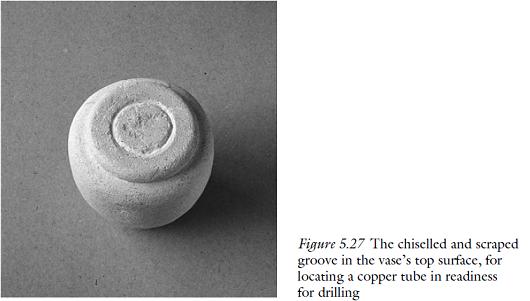
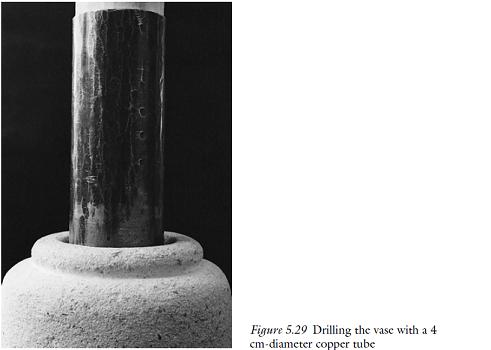
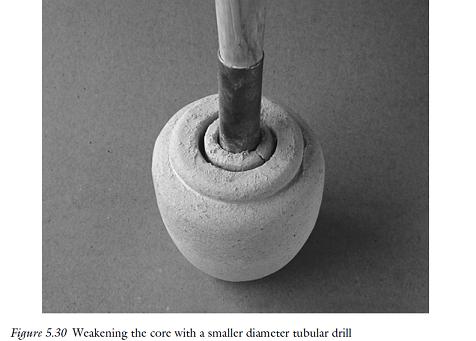
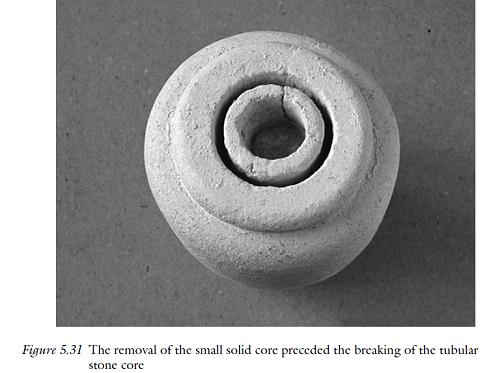
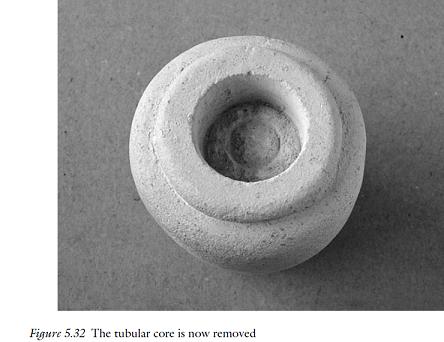

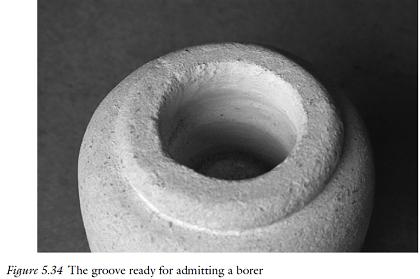
Note, in the example i'm about to post, he uses limetone, not hardstone (granite, diorite etc.), but he provides tested calculations on how much longer it would approx. take to manufacture such a vessel. I highly recommend reading his work, his approach may not be novel, but it is sincere and very well presented. You be the judge if he accomplished to prove the AE's ability to create these stone vessels with the tools and materials at their disposal.
The experimental vase was carved to shape from a rough block of soft limestone with large and small copper adzes, flat and crosscut copper chisels, a mallet, flint chisels, punches and scrapers and sandstone rubbers. No set measurements were adhered to, the shape of the vase being achieved by acting upon intuitive judgements.
The shoulders of a barrel-shaped vase are wider than its flat bottom; it made sense to align the narrower base surface directly under the centre of the projected top surface, and ensure parallelism between them. The top and the bottom surfaces were finished before any further shaping took place.

The initial shaping of the curved sides now commenced (Figure 5.23). Copper adzes were utilized to pare away the limestone from the top to the bottom. However, a hand-held, adze-shaped flint blade could also have been employed for this operation: if this vessel had been manufactured from granite or porphyry, flint chisels and punches would have been used to chip away the stone. During this shaping, constant checking of the relationship between the top and the bottom surfaces to the curved sides became necessary.

The second phase of the barrel form could now begin. Using small copper chisels, a mallet, and flint scrapers of different shapes and sizes, allowed the shoulders and neck gradually to be carved into shape (Figure 5.24). After checking the final form of the vase, sandstone rubbers of graded textures were used to smooth the whole of its surface. The final smoothing, however, was deferred until the completion of the hollowing. The vase measured 10 cm in diameter, 10.7 cm in height, with a neck diameter and height of 7.5 cm and 1 cm respectively.
First, the drill-tube was correctly positioned, so that, so that a mark could be made around its circumference, which allowed a groove to be chipped out with a flint chisel and mallet, just inside the circular mark.
In fact, two grooves were so prepared, one within the other, in order that two different diameter tubes could be used for the drilling.

The experimental vase was now drilled to a depth of 3.5 cm with the 4 cm- and the 2.2 cm-diameter tubular drills (Figures 5.29, 5.30). The cores were carefully removed with a mallet and a copper chisel. Pieces of the solid core were removed first, followed by the tubular core (Figures 5.31, 5.32). The soft mallet blows were directed toward the centre of the vase.




The vase now required undercutting at the shoulders, and then hollowing to follow its external shape. There are several ways that this could have been achieved in ancient times. First, tubular drill the vase completely to the bottom and then bore out the remainder of the stone with figure-of-eight-shaped stone borers.
Second, tubular drill the vase to a point just below the shoulder and introduce a first figure-of-eight-shaped borer to force a sideways cut. This first borer would be slightly longer than the diameter of the tubular drill; the use of flint scrapers to scrape a slight groove in the wall of the hole would help in the introduction of this first figure-of-eight borer. Each successively longer figure-of-eight borer would further increase the undercutting to a point where downwards penetration became necessary.

Third, tubular drill the vase to a point just below the shoulders, then use only successively larger figure-of-eight borers until the bottom is reached. This method is not supported by the striations seen on extant figure-of-eight borers, which are under the borers’ extremities, not under their central parts. This indicates that such borers were always used to widen an existing hole. The second alternative was chosen for this particular vase, although methods need to be reviewed when taking into account other vessels’ shapes and stones.

edit on 10-1-2013 by talklikeapirat because: rstw
continued (see post above)
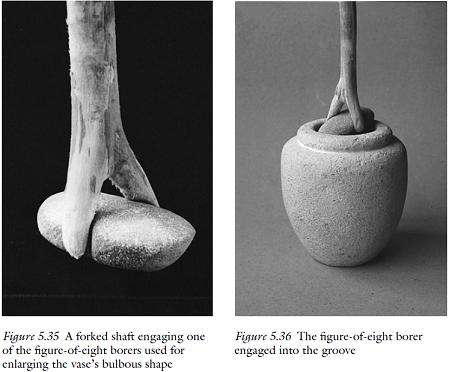
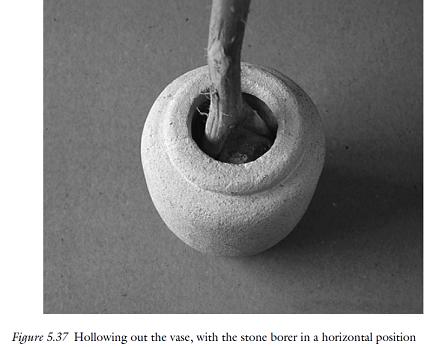
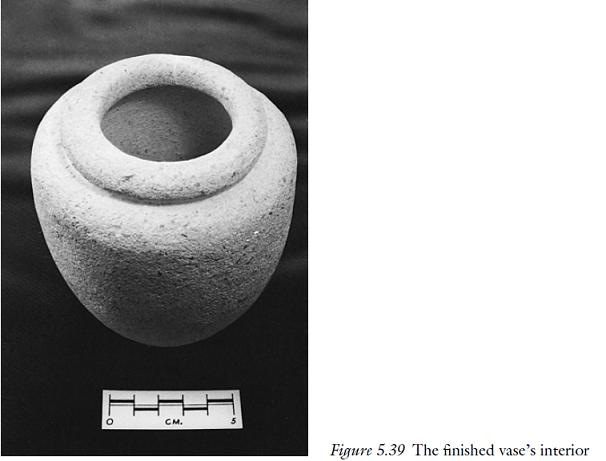
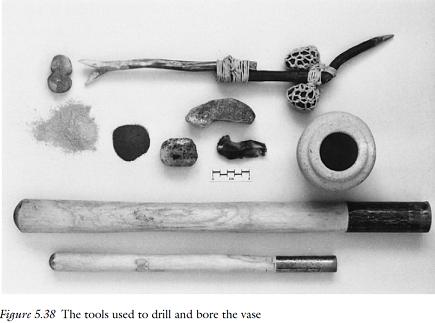
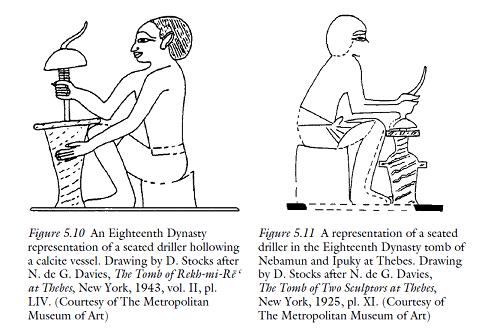
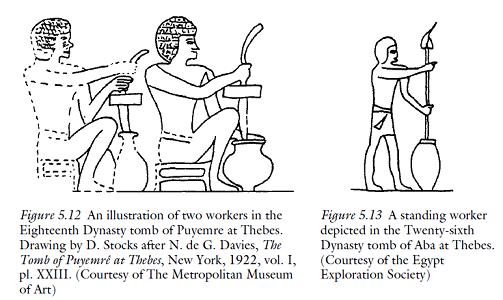
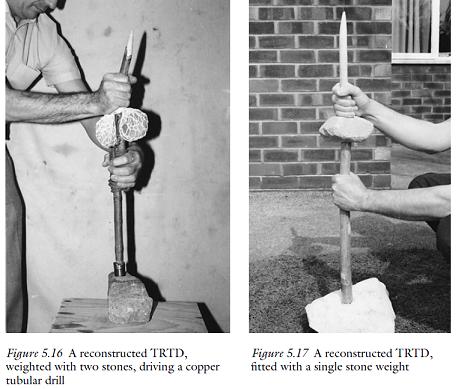

You be the judge, but there you have it, according to ATS unofficial motto:
Pic's or it didn't happen.
EXPERIMENTS IN EGYPTIAN ARCHAEOLOGY
A first figure-of-eight borer, slightly longer than the hole diameter of 4 cm, was slipped lengthways, that is, with its long axis vertical, into the hole, and brought to a nearly horizontal position (Figures 5.35, 5.36). One end of the borer was located in the scraped groove.

The limestone vase was now filled with dry sand abrasive up to the level of the borer, and a forked shaft engaged with it. Gradual twist and reverse twist actions, together with a new grip every few twists, allowed the borer to settle into a fully horizontal position (Figure 5.37). The scraped groove was further cut sideways and downwards by these actions. The dry sand abrasive slowly eroded the vase interior, and also the borer. Occasionally, the sand powder was poured out of the vase, and fresh supplies admitted.

Tubular drilling continued to the bottom of the test vase, whereupon the cores were removed. Figure-of-eight borers finished the hollowing of the vase. A series of raised ridges, or cusps, were created as each successive borer ground away a groove into the vase’s wall. These were smoothed away by long, hand-held sandstone rubbers, the bottom being smoothed with a rounded stone borer, in use with sand abrasive.
It is likely that an ancient stone vessel worker gathered many stone borers of different shapes and sizes over a lifetime’s work. Just as a modern blacksmith keeps any special tool for possible future use, many borers in ancient tool collections would have been kept for such a purpose.
The maximum internal diameter of the vase measured 8 cm, its minimum diameter being 5.5 cm, with a mouth diameter of 4.5 cm and a depth of 10 cm (Figures 5.38, 5.39). The total time for manufacture was 221⁄2 hours.


The earliest historical evidence for the TRTD ( twist / reverse twist drilling) comes from the Third Dynasty. The latest dated scene showing the tool is from the Twenty-sixth Dynasty, the tomb of Aba at Thebes, but it is reasonable to assume that the TRTD was in use to the end of Dynastic history. The rapid increase of stone vessel production in the Nagada II period, and the evidence of the craftworkers’ ability to make tubes of copper, are good grounds to suggest that this increase in stone vessel production was a direct result of joining the copper tube to the TRTD.




You be the judge, but there you have it, according to ATS unofficial motto:
Pic's or it didn't happen.
EXPERIMENTS IN EGYPTIAN ARCHAEOLOGY
reply to post by talklikeapirat
That's a pretty awsome post.
It really gets my goat when people disrespect the tremendous skills and patience it took to execute these stone forms, by claiming it couldn't be done.
That's a pretty awsome post.
It really gets my goat when people disrespect the tremendous skills and patience it took to execute these stone forms, by claiming it couldn't be done.
Originally posted by BanksyBoy
Shame he didn't attempt it in granite.
He did, sort of.
He conducted a series of experiments using copper tube drills on granite and hence knows the ratio. This was when he was also experimenting with sawing granite with copper slabbing saws with dry and wet sand abrasives.
IIRC, you can saw about 15 times the depth in limestone as you can in Aswan rose granite in equal amounts of time, according to Stocks' work.
BTW talklikeapirat, your link to Stock's book, which I have never seen in e-form, didn't work. I'd sure like to have it.
Harte
reply to post by Harte
It works fine for me, it's a pdf (it takes a while to load, link again) on sci-lib.net. I think i found it googling "Denys A. Stocks drilling", couldn't find any other copy online so far.
ETA. I just realised it's only the 5th chapter, starting at page 139 or so, but it was the chapter i was looking for.
It works fine for me, it's a pdf (it takes a while to load, link again) on sci-lib.net. I think i found it googling "Denys A. Stocks drilling", couldn't find any other copy online so far.
ETA. I just realised it's only the 5th chapter, starting at page 139 or so, but it was the chapter i was looking for.
edit on 10-1-2013 by
talklikeapirat because: (no reason given)
reply to post by talklikeapirat
talklikeapirat....
Thank you very much for posting the above information......at last some-one practicing what they preach and geting fair results......this is great stuff...
aaarrrrr....thank thee.....
talklikeapirat....
Thank you very much for posting the above information......at last some-one practicing what they preach and geting fair results......this is great stuff...
aaarrrrr....thank thee.....
Originally posted by Harte
Originally posted by BanksyBoy
Shame he didn't attempt it in granite.
He did, sort of.
He conducted a series of experiments using copper tube drills on granite and hence knows the ratio. This was when he was also experimenting with sawing granite with copper slabbing saws with dry and wet sand abrasives.
IIRC, you can saw about 15 times the depth in limestone as you can in Aswan rose granite in equal amounts of time, according to Stocks' work.
Harte
Sort off ???
Quite how messing about with a copper tube drill, sawing a cut in a slab then getting out a calculator can be compared to crafting a perfectly balanced and polished pot i have no idea. Well I suppose so long as that pleases you then that's ok then.
I wish these people keep who trying to tell us how something was done, will actually someday use the same materials i.e. Granite/Diorite etc, which the Egyptians seemed to have no problem crafting with by hand. For a big Brucie Bonus it would be good if they could even finish the job for once without having to resort to everything modern.
I guess I best not be holding my breath.
reply to post by talklikeapirat
I've had a quick browse through the pdf......for me personally....pure gold...
in one enlightening swoop the muddy waters were cleared.......
a 2003 publication and Denys A Stocks uses Petrie quite a bit.....
10 yrs old .......i wonder what mr Stocks has done since then?????
aaarrrr......thanks again..
I've had a quick browse through the pdf......for me personally....pure gold...
in one enlightening swoop the muddy waters were cleared.......
a 2003 publication and Denys A Stocks uses Petrie quite a bit.....
10 yrs old .......i wonder what mr Stocks has done since then?????
aaarrrr......thanks again..
while this is an interesting thread, and i applaud this kind of content appearing here and inviting debate (rather than more gun based boredom), the
reason that many of these items are celebrated is precisely due to the superb craftsmanship.
when humans spend their whole lives dedicated to a craft and have techniques passed down the generations then the results are often astounding. countless thousands of years making stone tools would have shown ancient makers that granite is emminently shapable a few grains at a time (try flintknapping with a granite hammerstone and see what happens to it) - things start to grow from there.
add to this some ancient technology such as drills (be they hand, bow or pump) and it is within very realistic reach of dedicted craftsmen. you realise you can drill in to hard rocks like granite and flint with nothing more than a length of cane and some sand? imaging a kid apprenticed to his father for ten years or w/e practicing these skills with a master.
i know some skilled "primitve technologists" (novices by ancient standards) who could get close enough to this given the time.
ancient art is remarkable and totally human.
edit: talklikeapirat's post above illustrate this superbly
when humans spend their whole lives dedicated to a craft and have techniques passed down the generations then the results are often astounding. countless thousands of years making stone tools would have shown ancient makers that granite is emminently shapable a few grains at a time (try flintknapping with a granite hammerstone and see what happens to it) - things start to grow from there.
add to this some ancient technology such as drills (be they hand, bow or pump) and it is within very realistic reach of dedicted craftsmen. you realise you can drill in to hard rocks like granite and flint with nothing more than a length of cane and some sand? imaging a kid apprenticed to his father for ten years or w/e practicing these skills with a master.
i know some skilled "primitve technologists" (novices by ancient standards) who could get close enough to this given the time.
ancient art is remarkable and totally human.
edit: talklikeapirat's post above illustrate this superbly
edit on 10-1-2013 by skalla because: (no reason given)
new topics
-
The Good News According to Jesus - Episode 1
Religion, Faith, And Theology: 8 minutes ago -
HORRIBLE !! Russian Soldier Drinking Own Urine To Survive In Battle
World War Three: 2 hours ago -
Bobiverse
Fantasy & Science Fiction: 5 hours ago -
Florida man's trip overseas ends in shock over $143,000 T-Mobile phone bill
Social Issues and Civil Unrest: 5 hours ago -
Former Labour minister Frank Field dies aged 81
People: 7 hours ago -
SETI chief says US has no evidence for alien technology. 'And we never have'
Aliens and UFOs: 9 hours ago -
This is our Story
General Entertainment: 11 hours ago
top topics
-
President BIDEN Vows to Make Americans Pay More Federal Taxes in 2025 - Political Suicide.
2024 Elections: 14 hours ago, 16 flags -
SETI chief says US has no evidence for alien technology. 'And we never have'
Aliens and UFOs: 9 hours ago, 6 flags -
Florida man's trip overseas ends in shock over $143,000 T-Mobile phone bill
Social Issues and Civil Unrest: 5 hours ago, 6 flags -
Former Labour minister Frank Field dies aged 81
People: 7 hours ago, 4 flags -
Ode to Artemis
General Chit Chat: 14 hours ago, 3 flags -
This is our Story
General Entertainment: 11 hours ago, 3 flags -
Bobiverse
Fantasy & Science Fiction: 5 hours ago, 3 flags -
HORRIBLE !! Russian Soldier Drinking Own Urine To Survive In Battle
World War Three: 2 hours ago, 1 flags -
The Good News According to Jesus - Episode 1
Religion, Faith, And Theology: 8 minutes ago, 0 flags
active topics
-
HORRIBLE !! Russian Soldier Drinking Own Urine To Survive In Battle
World War Three • 10 • : RazorV66 -
The Good News According to Jesus - Episode 1
Religion, Faith, And Theology • 0 • : randomuser2034 -
Florida man's trip overseas ends in shock over $143,000 T-Mobile phone bill
Social Issues and Civil Unrest • 11 • : pianopraze -
Who are the Russians?
New World Order • 202 • : twistedpuppy -
1980s Arcade
General Chit Chat • 26 • : xWorldxGonexMadx -
SETI chief says US has no evidence for alien technology. 'And we never have'
Aliens and UFOs • 31 • : andy06shake -
President BIDEN Vows to Make Americans Pay More Federal Taxes in 2025 - Political Suicide.
2024 Elections • 69 • : underpass61 -
Thousands Of Young Ukrainian Men Trying To Flee The Country To Avoid Conscription And The War
Other Current Events • 132 • : yuppa -
University student disciplined after saying veganism is wrong and gender fluidity is stupid
Education and Media • 47 • : Consvoli -
-@TH3WH17ERABB17- -Q- ---TIME TO SHOW THE WORLD--- -Part- --44--
Dissecting Disinformation • 647 • : daskakik
